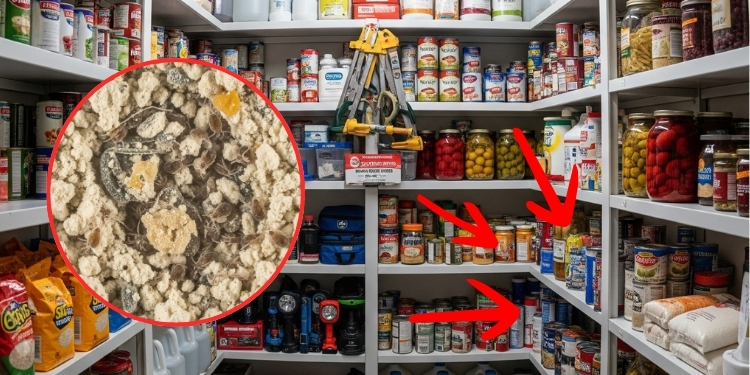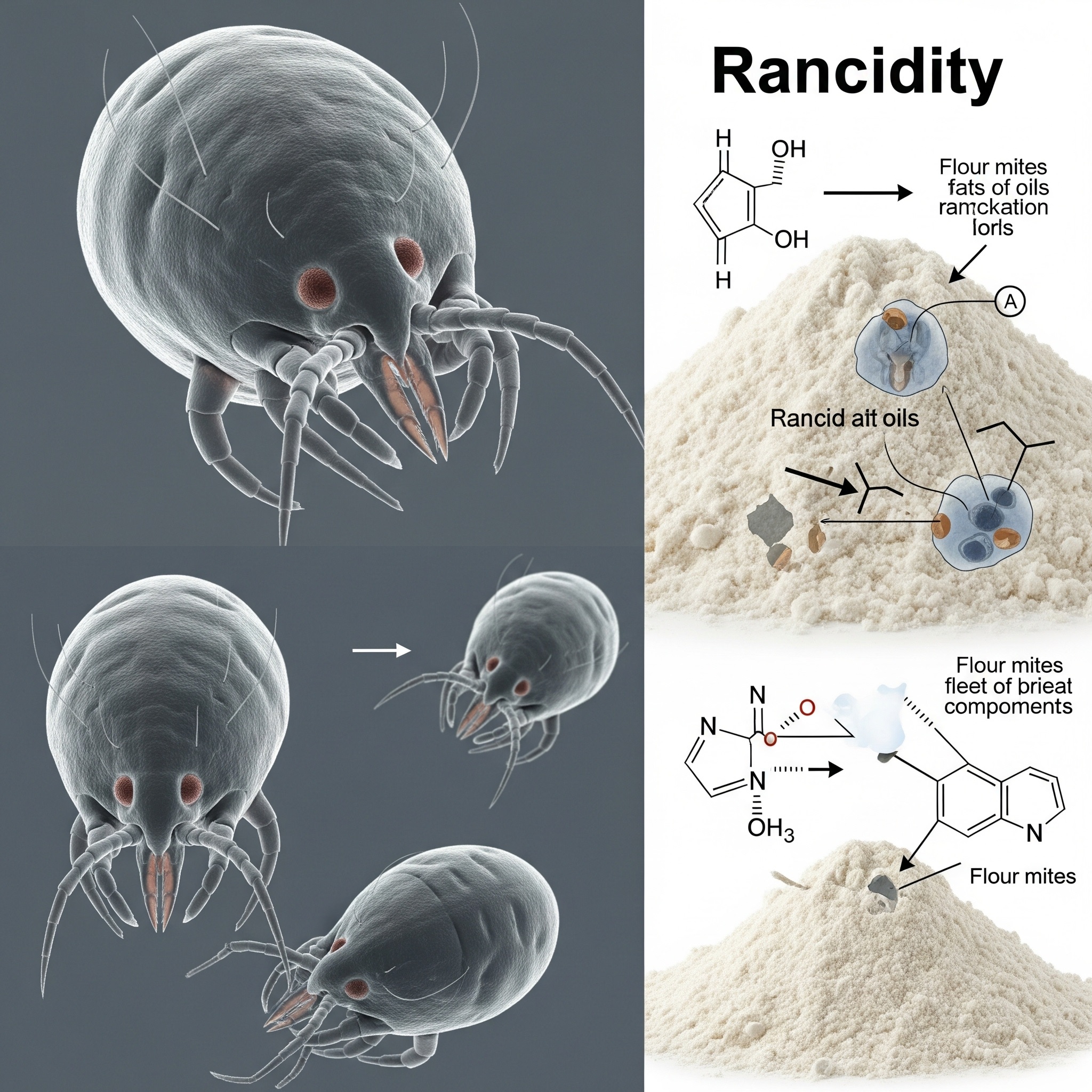Remove THIS From Your Pantry

Flour mites are one of the biggest threats to your food stockpile – yet most preppers don’t realize it until it’s too late. In any long-term crisis, securing a reliable food supply is crucial for survival. Growing your own crops is a smart plan, but it could take up to a year before you can truly rely on them. Hunting and foraging might not be safe either, especially after a nuclear or chemical disaster. That’s why a well-planned food stockpile is vital to get through the first critical months.
Sure, you can load up on canned vegetables, but what about bread? With fresh bread spoiling quickly – and hardtack being a miserable alternative – many turn to storing flour. Unfortunately, unless stored properly, your flour can become infested with flour mites, silently destroying your supply before you ever get to use it.
The Truth About Flour Mites and Long-Term Food Storage
The logical solution seems to be storing bread-making ingredients instead. Bread requires surprisingly few components: salt, sugar, fat (items most households already have), a leavening agent like sourdough starter (which outlasts commercial yeast’s two-year shelf life), and flour.
Flour appears to be the perfect solution. It’s readily available in bulk quantities, as many suppliers offer convenient 50-pound sacks with delivery options. The cost remains reasonable, and the math looks compelling: a few large sacks could theoretically support bread-making for years.
However, there’s hidden complexity beneath this seemingly simple storage strategy. Several significant factors affect flour’s long-term viability, and they might surprise you. These considerations are important enough that you may want to ask yourself whether storing more than a month or two’s worth actually serves your preparedness goals.

Flour Is a Pest Magnet
The very thing that makes flour useful – being an energy-dense carbohydrate – also makes it irresistible to vermin. Mice, rats, and a whole array of insects will attack it if given the opportunity. You can reduce this risk by storing flour in food-grade plastic barrels, but a determined rat might still chew its way in.
It’s also difficult to prevent smaller insects from getting in every time you open the barrel. Once they gain access, an infestation can ruin the entire contents very quickly. Biscuit weevils (the same insects that used to burrow into hardtack on old sailing ships) are a common pest in flour.
They’re not poisonous, and in an emergency, flour with weevils in it can be eaten, but most people aren’t too keen on eating bread full of bugs and their feces.
The Bigger Problems: Flour Mites and Rancidity
A worse problem than weevils is flour mites. As you can guess from the name, these pests specialize in eating flour – and unlike weevils, which are brown beetles about an eighth of an inch long, flour mites are extremely hard to spot. They’re not much bigger than a grain of sugar, and they’re white, making them almost invisible to the naked eye.
The real danger with flour mites is that they’re not as harmless as weevils. Eating bread made from mildly contaminated flour may not hurt you, though it won’t taste great – but a serious flour mite infestation is another matter.

These mites produce allergens as they chew through your flour. They also contaminate it with bacteria and mold spores. Flour with a heavy flour mite infestation can make you sick. And unless you freeze your flour, storing it long-term almost guarantees an infestation.
Even without pests, flour has another issue: it contains a small amount of natural oil. Over time, that oil turns rancid. After just a few months, your flour may produce bread that tastes bitter and unpalatable.
So, No Bread Then?
You can still have bread, even without storing flour. The better alternative is to stockpile wheat berries instead. These are whole wheat grains with the inedible husk removed. They’re basically the raw material from which flour is made.
 From a prepping perspective, wheat berries are superior in almost every way. While flour may last a few months, properly stored wheat berries can last for decades. The kernel acts like a natural container, keeping out oxygen and preventing the internal oils from going rancid.
From a prepping perspective, wheat berries are superior in almost every way. While flour may last a few months, properly stored wheat berries can last for decades. The kernel acts like a natural container, keeping out oxygen and preventing the internal oils from going rancid.
Flour can be vacuum-packed, but it’s nearly impossible to remove all the air. Wheat berries, on the other hand, vacuum-pack very well – and that process can also kill any flour mites that might be present. Alternatively, you can store them in airtight containers with oxygen absorbers.
There is a community that has, over the course of centuries, perfected the art of making long-lasting bread using methods both practical and innovative. I learned one of these remarkable techniques first hand from a member of the Amish community, via The Amish Ways Book: a traditional recipe known as bread in a jar, originally brought over from Europe and carefully preserved through generations.
What makes this bread truly unique is that it isn’t baked in a conventional oven. Instead, it’s prepared and cooked directly inside glass jars, allowing it to be safely canned and stored for extended periods without refrigeration. By using this method, you not only avoid the risk of flour mites and mold, but you also gain a reliable way to preserve one of the most essential staple foods in your prepper pantry. The result is a shelf-stable, nutrient-rich bread that can last for months or even years when stored properly.
👉 Here’s how you can make Bread in a Jar!
What About Grinding?
Of course, you can’t bake bread from whole wheat berries – you’ll need a grinder. But that’s a one-time investment. If you already bake your own bread, it’s worth knowing that wheat berries are often cheaper per pound than flour. Plus, grinding your own flour means it’s always fresh and safe.
You can also cook wheat berries whole, much like rice or barley. They’re versatile and nutritious, making them a valuable staple in your pantry.
One Last Thing
Flour mites are more than a nuisance. They can trigger allergic reactions, digestive issues, and contaminate your entire food supply. And if you think avoiding gluten is enough to stay protected, think again.
Many people try to live clean and eat smart, but unknowingly sabotage their health in other ways. Most so-called “natural” products on store shelves are filled with toxic junk. Synthetic preservatives, hormone disruptors, chemical emulsifiers with names you can’t pronounce and dangers no one talks about.
 These toxins are absorbed directly through your skin and mouth, entering your bloodstream without any filter. So while you’re trying to heal your body with healthy food, you might be damaging it with everyday personal care products. But there is a better way.
These toxins are absorbed directly through your skin and mouth, entering your bloodstream without any filter. So while you’re trying to heal your body with healthy food, you might be damaging it with everyday personal care products. But there is a better way.
There’s a powerful book written by Nicole Apelian that shows you how to take back control. Inside, you’ll find over 250 herbal remedy recipes, including safe, homemade alternatives to toxic everyday items. Think herbal toothpaste, natural deodorant sticks, healing facial oils, salves, and even a “Better Than Botox” cream.
No synthetic chemicals. No mystery ingredients. Just real remedies your body actually recognizes.
👉 Click here to discover the recipes and detox your routine. This might be the most important prep you make.
Final Thoughts: Flour vs. Wheat Berries
Flour might seem like a sensible item for preppers to stockpile – but the truth is, its drawbacks make it more of a liability. Between its limited shelf life, the near-inevitable threat of flour mites, the risk of rancidity, and the potential for illness, flour doesn’t belong in your long-term storage plan.
To maximize your chances of survival – and minimize waste – it’s time to phase out flour and replace it with wheat berries. They’re safer, longer-lasting, and just as useful when properly stored and prepared.
You may also like:

Foods You Should Never Wash
The ONLY Foods You Need to Stockpile (Video)
This is How My Grandma Made Antibiotics
Why You Should Freeze Flour Before Storing It
Plants You Should Grow Around Your House To Repel Insects And Bugs (Including Termites)
Read the full article here









